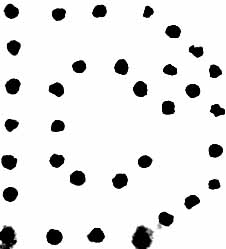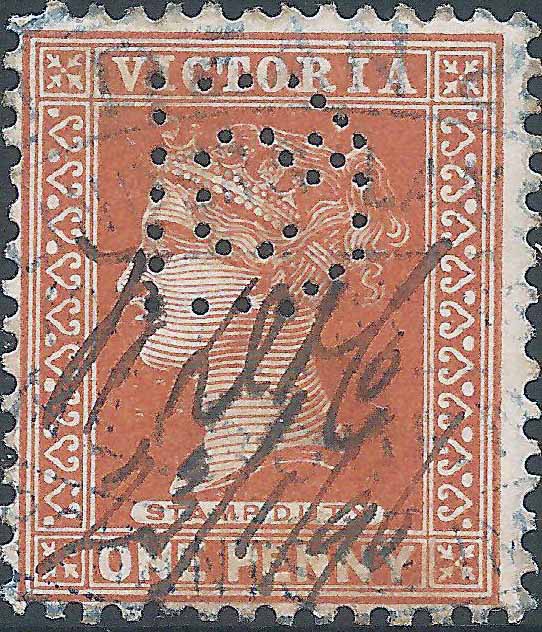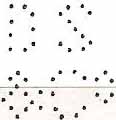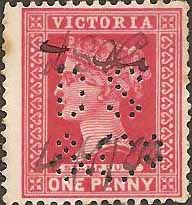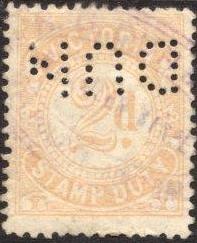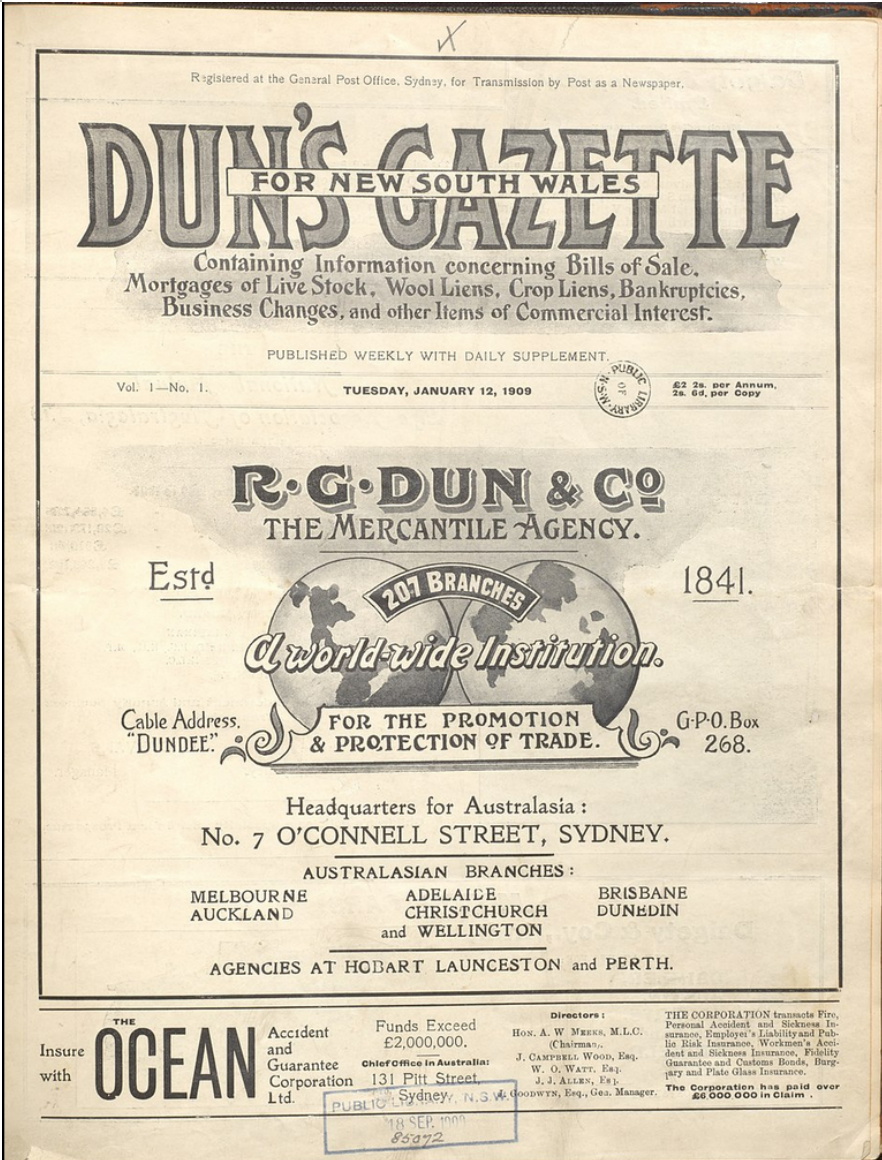|
Private Revenue Perfins of Victoria An Elsmore Coath production The authors would welcome your comments additions or input into this work A B C D E F G H I J K L M N O P Q R S T U V W Y Other D -------------------------------------------------------- DCo.a
User: W Dean & Co, later W & G Dean & Co, later Deans Oil & Colour Merchants Address: Equitable Place (off Collins St), Melbourne, VIC Warehouse at Flinders Lane (East), Melbourne, VIC Revenue Use: 1886-1899 Series, inscribed 'STAMP DUTY' 1d (shades) Rarity Scale:
1886-1899 Series 1d R4
Background: *Note: In previous studies of Australian Private Perfins this pattern was provisionally assigned to Dalgety & Co. but this pattern has now been proved to Dean & Co because of a partial company cachet found on a revenue stamp which carried the words “Dean &….” As reported in SPPB #105 of April 2014.
Dean & Co (later W & G Dean & Co) was established in 1854 by brothers William & George Dean, the first Dean & Co. emporium was located off Elizabeth St, adjoining the then “Age” newspaper's office. As Melbourne grew, so too did Deans, expanding into the Age building and then to a five storey complex in Equitable Place (off Collins St).
The company specialised in brushes, paints and artists materials as well as building and painters material such as non-corrosive paints, varnishes, paper hangings, oils, paints, glass, and later bitumen roof sealants.
In 1880 Dean & Co. was one of the first businesses in Melbourne to use the new Edison-Bell phone and in 1896 their warehouse in Flinders lane was damaged by a serious fire that also damaged the building of fellow perfin user Beath, Schiess & Co.
The company continued to trade in the 20th Century and was later know as Deans, and they expanded into students needs by the 1960’s. In the mid 1980's they amalgamated with the Camden Art Centre (est. 1946) and the company become one of the largest retailers of art supplies in the southern hemisphere.
As of 2014 Deans Art is still an Australian owned & operated business, supplying expert advice and products to artists, designers & craftsmen from all spectrums, be they professional, student or hobbyists alike.
Device: The DCo.a pattern is made from a temporary die in a single die format. Such devices, which could produce these temporary patterns, were used by some Stamp Vendors in Melbourne from late 1800’s and early part of the 20th Century. This particular pattern is known used in 1896. It is most commonly found on postage stamps. Related Patterns: Refer to other Dean & Co patterns in: VIC: W&/GD.a * Trove -------------------------------------------------------- DS/&Co.a
User: Dodgshun & Sons(unconfirmed) or David Syme & Co(unconfirmed) Address: Revenue Use: 1886-1899 Series, inscribed 'STAMP DUTY' 1d (shades) Rarity Scale:
1886-1899 Series 1d R4
Background: *User uncertain for Backgrounds of possible users companies see: Dodgshun & Sons: refer to the William Dodgshun & Co under W David Syme & Co: refer to the “Other” Section – Commercial Overprints letter D There is more evidence to support the case for Dodgshun & Sons as the user than there is for David Syme & Co and this is due to evidence of perfin use in Tasmania. There is a DS/&Co pattern that is made by a single die customised device with a similar scale and layout found used in Launceston. This DS/&Co device is attributed to Dodgshun & Sons, as they were known to have conducted a business from there prior to expanding to Melbourne and New Zealand. In fact there have been some reports of DS/&Co like patterns made by temporary dies, such as the one that made DS/&Co.a, used in Tasmania. This is not consistent with our findings as all DS/&Co and indeed DS/&C patterns that we have seen, that are made from Temporary dies, carry Melbourne postmarks, which is consistent with the main location of the Stamp Vendors that used these Temporary devices. Device: The DS/&Co.a pattern is made from a temporary die in a single die format. Such devices, which could produce these temporary patterns, were used by some Stamp Vendors in Melbourne from late 1800’s and early part of the 20th Century. This particular pattern is known used in 1900. It is most commonly found on postage stamps. Related Patterns: Refer to possible users patterns as follows: Dodgshun & Sons: VIC: WD/&Co.a, WD/&Co.b WD/&S.a David Syme & Co: VIC: Other – Section 2 Commercial Overprints DAVID SYME/& CO. LIMITED.a , .b, .c and .d *Tasmanian Philatelic Society Bulletin Board -------------------------------------------------------- DUN.a
User: R G Dun Credit
Agency Address:60 Queen
St, Melbourne, Victoria Revenue Use: 1915 Numeral Series Rarity Scale:
1915 Numeral Series 1d R4
Background: # Dun (later &
Bradstreet) traces its history from 20 July 1841,
with founding of the “Mercantile Agency” in New
York (US) by Lewis Tappan, later called “R. G. Dun
& Company”. Tappan saw the need
for a centralized credit reporting system and
built up a network of correspondents who would
provide reliable, objective credit information
to subscribers. By 1844 the
“Mercantile Agency” had over 280 clients with
offices in Boston, Philadelphia, and Baltimore.
In 1849, Tappan retired and Benjamin Douglass
took over but in 1859, Douglass transferred the
company to Robert Graham Dun, who immediately
changed the firm's name to R. G. Dun &
Company. Over the next
40 years, Graham Dun continued to expand the
business across the USA and internationally and
in the early 1900’s the company had over 200
branches. In Australia
and New Zealand, the company was headquartered
in Sydney at 7 O’Connell Street, with offices in
Melbourne, Adelaide, Brisbane, Auckland,
Christchurch, Dunedin and Wellington as well as
agencies. In each office
the company issued a regular series of
publications entitled “Dun’s Gazette” which
detailed commercial information such as stock
and commodity prices, mortgages, business
changes, bankruptcies, new business listings,
dividends, notices, and other matters of
commercial interest. In March 1933, Dun
merged with competitor John M. Bradstreet to
form Dun & Bradstreet and the merged company
extended its range of products and services. In 1962 the company
acquired the Credit rating agency “Moody’s” and
the combined company became a corner stone of
Business reporting across the world. Device: The DUN.a
device is a single die customised perforator that
came into service in Melbourne about 1921 and
remained in use until at least 1938. The pattern is
common on postage stamps, but it is extremely rare
on revenue stamps which is odd considering the
range of commercial activities that the company
was involved in. The device
appeared to be sound in the period of late usage
and we can offer no explanation of its
discontinuance or indeed why the Melbourne office
was the only Australian or New Zealand office to
use a perforator. Related patterns:
Nil
# Dun and
Bradstreet, Wikipedia, Trove
-------------------------------------------------------- A B C D E F G H I J K L M N O P Q R S T U V W Y Other © copyright 2011 |
